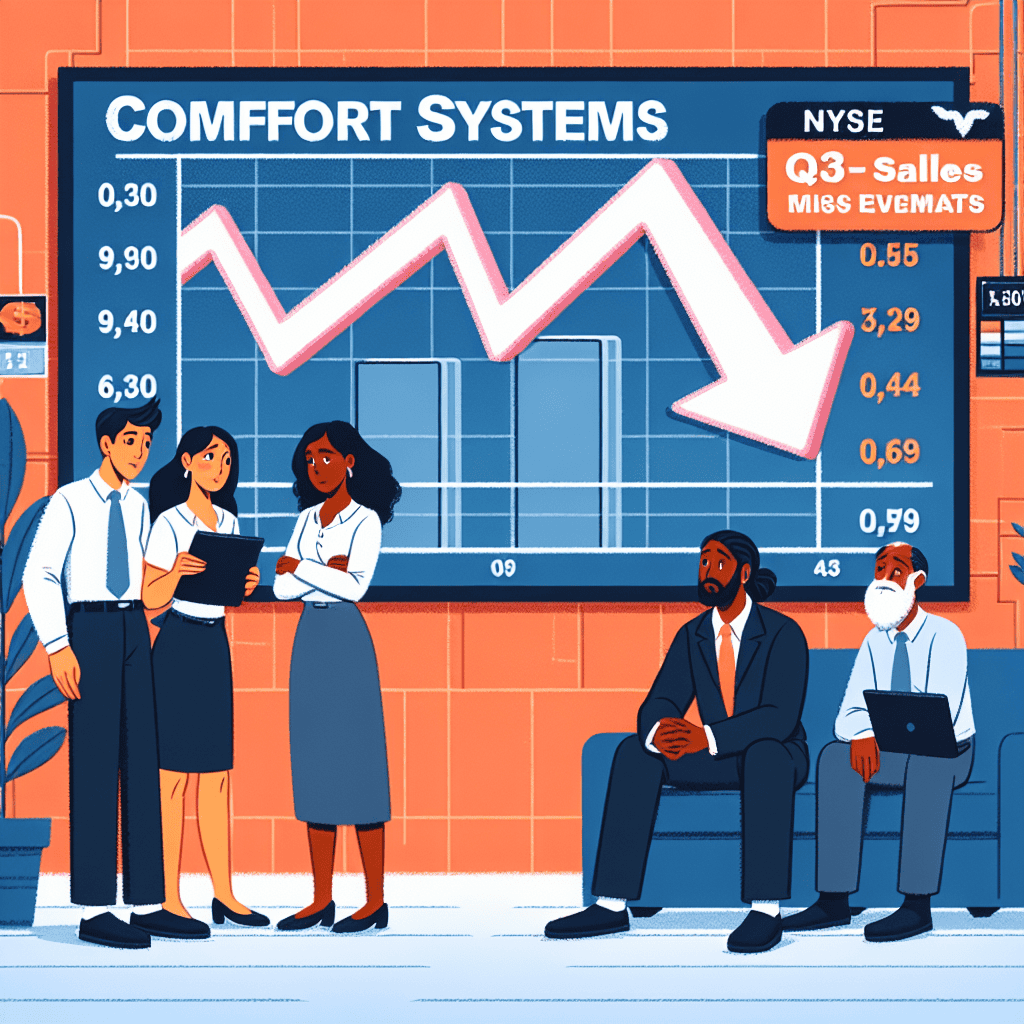“Comfort Systems’ Q3 Sales Fall Short, Shares Take a Hit.”
Introduction
Comfort Systems USA, Inc. (NYSE: FIX), a leading provider of mechanical services including heating, ventilation, and air conditioning (HVAC), recently reported its financial results for the third quarter. The company’s sales figures fell short of market expectations, leading to a decline in its share price. Despite efforts to navigate a challenging economic environment, the sales miss has raised concerns among investors about the company’s near-term growth prospects. The underperformance in sales has prompted a reassessment of Comfort Systems’ strategies and market positioning as it seeks to regain investor confidence and stabilize its financial outlook.
Analysis Of Comfort Systems’ Q3 Sales Performance
In the third quarter of the fiscal year, Comfort Systems USA, Inc. (NYSE:FIX) reported sales figures that fell short of analysts’ expectations, leading to a noticeable decline in its share price. This development has prompted a closer examination of the factors contributing to the company’s underperformance and the potential implications for its future trajectory. As a leading provider of mechanical services, Comfort Systems has historically been a strong player in the construction and maintenance of HVAC, electrical, and plumbing systems. However, the recent sales miss has raised questions about its current market position and operational strategies.
To begin with, the company’s Q3 sales figures were impacted by a combination of external and internal factors. Externally, the macroeconomic environment has been challenging, with inflationary pressures and supply chain disruptions affecting many industries, including construction and building services. These challenges have led to increased costs for materials and labor, which in turn have squeezed profit margins. Additionally, the ongoing volatility in the global economy has resulted in delayed projects and cautious spending by clients, further dampening sales growth.
Internally, Comfort Systems has faced its own set of challenges. The company has been navigating through a period of strategic realignment, aiming to optimize its operations and enhance its service offerings. While these efforts are crucial for long-term growth, they have temporarily diverted resources and focus away from immediate sales generation. Moreover, the integration of recent acquisitions has been more complex than anticipated, leading to inefficiencies and slower-than-expected synergies. These internal dynamics have compounded the difficulties posed by the external environment, contributing to the sales shortfall.
Despite these setbacks, it is important to recognize that Comfort Systems remains fundamentally strong. The company has a robust portfolio of services and a diverse client base, which provide a solid foundation for future growth. Furthermore, the long-term demand for HVAC and mechanical services is expected to remain strong, driven by factors such as urbanization, the need for energy-efficient solutions, and the ongoing maintenance requirements of existing infrastructure. These trends suggest that Comfort Systems is well-positioned to capitalize on future opportunities once the current challenges are addressed.
In response to the Q3 sales miss, Comfort Systems’ management has reiterated its commitment to improving operational efficiency and enhancing shareholder value. The company is actively working to streamline its supply chain processes and mitigate the impact of rising costs. Additionally, efforts are underway to accelerate the integration of recent acquisitions, with a focus on realizing synergies and expanding service capabilities. These initiatives are expected to bolster the company’s competitive position and drive future sales growth.
In conclusion, while Comfort Systems’ Q3 sales performance has been disappointing, it is essential to view this in the context of broader industry challenges and the company’s ongoing strategic initiatives. The decline in share price reflects investor concerns, but it also presents an opportunity for the company to demonstrate resilience and adaptability. By addressing both external and internal challenges, Comfort Systems can position itself for a stronger performance in the coming quarters. As the company navigates this period of transition, stakeholders will be closely monitoring its progress and the effectiveness of its strategic responses.
Factors Contributing To Comfort Systems’ Q3 Sales Miss
Comfort Systems USA, Inc. (NYSE:FIX), a leading provider of mechanical services including heating, ventilation, and air conditioning (HVAC) solutions, recently reported its financial results for the third quarter, revealing a sales performance that fell short of market expectations. This underperformance has led to a decline in the company’s share price, prompting investors and analysts to scrutinize the factors contributing to the sales miss. Understanding these elements is crucial for stakeholders aiming to assess the company’s future prospects and strategic direction.
One of the primary factors contributing to Comfort Systems’ Q3 sales miss is the ongoing supply chain disruptions that have affected numerous industries worldwide. The HVAC sector, in particular, has been grappling with shortages of critical components and materials, which have delayed project timelines and increased costs. These disruptions have not only hindered the company’s ability to meet customer demand promptly but have also pressured profit margins, as the cost of procuring scarce materials has risen. Consequently, the company’s revenue generation capabilities have been adversely impacted, contributing to the sales shortfall.
In addition to supply chain challenges, labor shortages have also played a significant role in the company’s underwhelming sales performance. The construction and mechanical services industries have been experiencing a dearth of skilled labor, which has been exacerbated by the ongoing economic recovery and increased demand for infrastructure projects. This shortage has led to project delays and inefficiencies, further compounding the difficulties faced by Comfort Systems in executing its contracts on time and within budget. As a result, the company’s ability to recognize revenue from completed projects has been impeded, contributing to the sales miss.
Moreover, the macroeconomic environment has also posed challenges for Comfort Systems during the third quarter. Rising interest rates and inflationary pressures have led to increased costs for both businesses and consumers, potentially dampening demand for new construction and renovation projects. As clients reassess their budgets and project timelines in response to these economic conditions, the demand for HVAC services may have been negatively affected, thereby impacting Comfort Systems’ sales performance.
Furthermore, competitive pressures within the HVAC industry have intensified, with numerous players vying for market share in a challenging economic landscape. This heightened competition has necessitated aggressive pricing strategies, which may have further squeezed Comfort Systems’ margins and affected its top-line growth. The need to balance competitive pricing with maintaining profitability is a delicate task that the company must navigate carefully to sustain its market position.
Despite these challenges, it is important to note that Comfort Systems has been actively pursuing strategic initiatives to mitigate these adverse factors. The company has been investing in technology and innovation to enhance operational efficiency and reduce reliance on manual labor. Additionally, efforts to diversify its supply chain and establish more robust relationships with suppliers are underway to alleviate material shortages. These initiatives, while promising, may take time to yield significant results, and their impact on future sales performance remains to be seen.
In conclusion, Comfort Systems’ Q3 sales miss can be attributed to a confluence of supply chain disruptions, labor shortages, macroeconomic challenges, and competitive pressures. While these factors have undeniably affected the company’s recent performance, its strategic initiatives aimed at addressing these issues offer a glimmer of hope for improved future outcomes. Investors and stakeholders will be closely monitoring the company’s progress in navigating these challenges as they evaluate its long-term growth potential.
Market Reaction To Comfort Systems’ Q3 Earnings Report
Comfort Systems USA, Inc. (NYSE:FIX), a leading provider of mechanical services including heating, ventilation, and air conditioning (HVAC) installation, maintenance, and repair, recently released its third-quarter earnings report, which fell short of market expectations. This underperformance has led to a noticeable decline in the company’s share price, reflecting investor disappointment and concern over the company’s near-term prospects. As the market digests the implications of these results, it is essential to understand the factors contributing to the sales miss and the subsequent market reaction.
The third-quarter earnings report revealed that Comfort Systems’ sales figures did not meet analysts’ estimates, which had been set based on the company’s previous performance and market conditions. Despite a generally favorable economic environment and a robust construction sector, the company’s revenue growth was hindered by several challenges. Supply chain disruptions, which have been a persistent issue across various industries, played a significant role in limiting the company’s ability to meet demand. Additionally, labor shortages have further exacerbated operational inefficiencies, making it difficult for Comfort Systems to capitalize fully on available opportunities.
In response to the earnings miss, Comfort Systems’ shares experienced a decline, as investors reassessed their positions in light of the new information. The stock market, known for its sensitivity to earnings reports, often reacts swiftly to any deviation from expected performance. In this case, the sales shortfall prompted a reevaluation of the company’s growth trajectory and profitability outlook. Investors, who had previously been optimistic about Comfort Systems’ ability to navigate the current economic landscape, are now more cautious, leading to a sell-off in the stock.
Moreover, the broader market context has also influenced the reaction to Comfort Systems’ earnings report. With rising interest rates and inflationary pressures, investors are increasingly focused on companies’ abilities to maintain margins and sustain growth. In this environment, any indication of operational challenges or financial underperformance can lead to heightened scrutiny and volatility in stock prices. Comfort Systems, facing both industry-specific and macroeconomic headwinds, has found itself under the microscope as investors seek to understand the long-term implications of its current struggles.
Despite the immediate negative reaction, it is important to consider the potential for recovery and growth in the future. Comfort Systems has a strong track record and a solid market position, which could enable it to overcome the current challenges. The company may implement strategic initiatives to address supply chain issues and labor shortages, potentially improving its operational efficiency and financial performance. Furthermore, the ongoing demand for HVAC services, driven by factors such as climate change and energy efficiency regulations, provides a favorable backdrop for long-term growth.
In conclusion, while Comfort Systems’ third-quarter earnings report has led to a decline in its share price, the market reaction reflects broader concerns about the company’s ability to navigate current challenges. Investors are closely monitoring the situation, weighing the potential for recovery against the risks posed by supply chain disruptions and labor shortages. As the company works to address these issues, its future performance will be critical in determining whether it can regain investor confidence and achieve sustainable growth.
Impact Of Q3 Sales Miss On Comfort Systems’ Stock Price

Comfort Systems USA, Inc. (NYSE:FIX), a leading provider of mechanical services including heating, ventilation, and air conditioning (HVAC) solutions, recently reported its financial results for the third quarter. The company’s sales figures fell short of analysts’ expectations, leading to a noticeable decline in its stock price. This development has sparked discussions among investors and market analysts regarding the potential implications for the company’s future performance and stock valuation.
The third-quarter sales miss can be attributed to several factors that have impacted Comfort Systems’ operations. Firstly, the company has faced supply chain disruptions, a challenge that has been prevalent across various industries. These disruptions have led to delays in project completions and increased costs, thereby affecting the company’s revenue generation. Additionally, fluctuating raw material prices have further compounded these challenges, squeezing profit margins and making it difficult for the company to maintain its previous growth trajectory.
Moreover, the broader economic environment has also played a role in the company’s underperformance. With inflationary pressures and rising interest rates, many businesses have become more cautious in their capital expenditures, including investments in HVAC systems. This cautious approach has resulted in a slowdown in new project orders for Comfort Systems, thereby impacting its sales figures for the quarter. Furthermore, the labor market has posed additional challenges, as the company has struggled to attract and retain skilled workers, which is crucial for executing its projects efficiently.
In response to the sales miss, Comfort Systems’ stock experienced a decline, reflecting investor concerns about the company’s ability to navigate these challenges effectively. The stock market often reacts swiftly to earnings reports, and in this case, the sales miss has led to a reassessment of the company’s growth prospects. Investors are now closely monitoring how Comfort Systems plans to address these issues and whether it can regain its footing in the coming quarters.
Despite the current setback, it is important to consider the company’s long-term potential. Comfort Systems has a strong track record of delivering quality services and maintaining solid customer relationships. The demand for HVAC solutions is expected to remain robust, driven by factors such as urbanization, climate change, and the need for energy-efficient systems. As such, the company is well-positioned to capitalize on these trends once the immediate challenges are addressed.
To mitigate the impact of the sales miss and restore investor confidence, Comfort Systems may need to implement strategic measures. These could include optimizing its supply chain operations, exploring cost-saving initiatives, and investing in workforce development to ensure it has the necessary talent to meet project demands. Additionally, the company might consider enhancing its focus on innovation and sustainability, which could open up new revenue streams and strengthen its competitive position in the market.
In conclusion, while Comfort Systems’ third-quarter sales miss has led to a decline in its stock price, it is crucial to view this development within the broader context of the challenges facing the industry. The company’s ability to adapt to these challenges and leverage its strengths will be key to its future success. Investors and stakeholders will be keenly observing how Comfort Systems navigates this period of uncertainty and whether it can emerge stronger in the long run.
Strategic Adjustments For Comfort Systems Post-Q3 Results
Comfort Systems USA, Inc. (NYSE:FIX), a leading provider of mechanical services including heating, ventilation, and air conditioning (HVAC) solutions, recently reported its third-quarter financial results, which fell short of market expectations. The company’s sales figures did not meet analysts’ estimates, leading to a decline in its share price. This development has prompted a strategic reassessment within the company as it seeks to navigate the challenges posed by the current economic landscape and align its operations with evolving market demands.
In the wake of the disappointing sales performance, Comfort Systems is focusing on several strategic adjustments to bolster its market position and enhance shareholder value. One of the primary areas of focus is operational efficiency. By streamlining processes and optimizing resource allocation, the company aims to reduce costs and improve profit margins. This approach not only addresses immediate financial concerns but also positions Comfort Systems for long-term sustainability in a competitive industry.
Moreover, the company is placing a renewed emphasis on innovation and technological advancement. As the HVAC industry undergoes significant transformation driven by environmental concerns and regulatory changes, Comfort Systems recognizes the importance of staying ahead of the curve. By investing in research and development, the company seeks to introduce cutting-edge solutions that meet the growing demand for energy-efficient and environmentally friendly systems. This strategic pivot is expected to not only attract new customers but also strengthen relationships with existing clients who are increasingly prioritizing sustainability.
In addition to operational and technological enhancements, Comfort Systems is also exploring opportunities for strategic partnerships and acquisitions. By collaborating with other industry players and expanding its portfolio through targeted acquisitions, the company aims to diversify its offerings and enter new markets. This approach not only mitigates risks associated with market fluctuations but also provides a platform for accelerated growth. Furthermore, strategic partnerships can facilitate knowledge sharing and innovation, enabling Comfort Systems to leverage external expertise and resources.
While these strategic adjustments are crucial, Comfort Systems is also mindful of the importance of maintaining a strong customer focus. The company is committed to enhancing customer satisfaction by delivering high-quality services and solutions tailored to individual client needs. By fostering strong relationships and maintaining open lines of communication, Comfort Systems aims to build trust and loyalty among its customer base. This customer-centric approach is expected to drive repeat business and generate positive word-of-mouth referrals, further solidifying the company’s market position.
In conclusion, Comfort Systems’ Q3 sales miss has served as a catalyst for strategic realignment within the company. By prioritizing operational efficiency, innovation, strategic partnerships, and customer satisfaction, Comfort Systems is positioning itself to overcome current challenges and capitalize on future opportunities. While the road ahead may be fraught with uncertainties, these strategic adjustments reflect the company’s commitment to adaptability and resilience. As Comfort Systems navigates this transitional phase, stakeholders can expect a renewed focus on sustainable growth and value creation, ensuring the company’s continued success in an ever-evolving industry landscape.
Investor Sentiment Following Comfort Systems’ Q3 Earnings
In the wake of Comfort Systems USA, Inc.’s (NYSE:FIX) recent third-quarter earnings report, investor sentiment has been notably impacted, as evidenced by the decline in the company’s share price. The report revealed that the company’s sales figures fell short of analysts’ expectations, a development that has prompted a reassessment of the company’s financial health and future prospects among investors. As the market digests this information, it is crucial to understand the underlying factors contributing to the sales miss and the subsequent reaction from the investment community.
To begin with, Comfort Systems’ Q3 earnings report highlighted a revenue shortfall that caught many investors off guard. Analysts had anticipated stronger sales performance, given the company’s previous track record of steady growth and its position within the HVAC services industry. However, the reported figures did not align with these expectations, leading to a recalibration of investor outlooks. This discrepancy between anticipated and actual performance can be attributed to several factors, including potential supply chain disruptions, fluctuating demand in key markets, and competitive pressures that may have affected the company’s ability to secure new contracts or maintain existing ones.
Moreover, the broader economic environment has also played a role in shaping investor sentiment. With ongoing concerns about inflation, interest rate hikes, and geopolitical tensions, the market has been particularly sensitive to any signs of weakness in corporate earnings. In this context, Comfort Systems’ sales miss has been perceived as a potential indicator of broader challenges facing the industry, prompting investors to adopt a more cautious stance. This cautiousness is reflected in the decline of the company’s share price, as market participants reassess their risk exposure and adjust their portfolios accordingly.
In addition to these external factors, internal dynamics within Comfort Systems may have also contributed to the sales miss. The company has been navigating a period of strategic transformation, with efforts to expand its service offerings and enhance operational efficiencies. While these initiatives are aimed at driving long-term growth, they may have temporarily diverted resources and attention away from immediate sales objectives. Consequently, investors are now closely monitoring the company’s ability to balance its strategic ambitions with the need to deliver consistent financial performance.
Despite the current challenges, it is important to note that Comfort Systems remains a significant player in the HVAC services sector, with a strong foundation and a history of resilience. The company’s management has expressed confidence in its ability to overcome the present hurdles and capitalize on future opportunities. This optimism is rooted in the belief that the underlying demand for HVAC services will continue to grow, driven by factors such as urbanization, climate change, and the increasing emphasis on energy efficiency.
In conclusion, while Comfort Systems’ Q3 sales miss has undoubtedly affected investor sentiment, it is essential to consider the broader context and the company’s long-term potential. As the market continues to evaluate the implications of the earnings report, investors will be keenly observing any strategic adjustments and operational improvements that the company undertakes. Ultimately, the ability of Comfort Systems to navigate the current landscape and deliver on its growth objectives will be pivotal in restoring investor confidence and driving future share price performance.
Future Outlook For Comfort Systems After Q3 Sales Decline
Comfort Systems USA, Inc. (NYSE:FIX), a leading provider of mechanical services including heating, ventilation, and air conditioning (HVAC), recently reported its third-quarter financial results, which fell short of market expectations. This shortfall in sales has led to a noticeable decline in the company’s share price, prompting investors and analysts to reassess the future outlook for the company. As the market digests these results, it is crucial to explore the factors contributing to the sales miss and the potential strategies Comfort Systems might employ to regain its footing.
To begin with, the third-quarter sales miss can be attributed to several factors, both internal and external. Externally, the macroeconomic environment has been challenging, with supply chain disruptions and inflationary pressures affecting many industries, including HVAC services. These disruptions have led to increased costs and delays in project completions, which in turn have impacted revenue recognition for Comfort Systems. Internally, the company may have faced operational challenges, such as labor shortages or inefficiencies, which could have further exacerbated the situation. Despite these hurdles, Comfort Systems has a history of resilience and adaptability, which could play a pivotal role in its recovery.
Looking ahead, Comfort Systems has several avenues to explore in order to improve its performance and restore investor confidence. One potential strategy is to enhance its focus on operational efficiency. By streamlining processes and optimizing resource allocation, the company can mitigate some of the cost pressures it currently faces. Additionally, investing in technology and innovation could provide Comfort Systems with a competitive edge, enabling it to deliver services more effectively and efficiently. This could involve adopting advanced HVAC technologies or leveraging data analytics to improve service delivery and customer satisfaction.
Moreover, Comfort Systems could benefit from diversifying its service offerings and expanding into new markets. The growing emphasis on energy efficiency and sustainability presents an opportunity for the company to develop and promote eco-friendly HVAC solutions. By aligning its services with the increasing demand for green technologies, Comfort Systems can tap into new customer segments and drive revenue growth. Furthermore, strategic acquisitions or partnerships could facilitate entry into untapped markets or enhance the company’s capabilities, providing additional growth avenues.
In addition to these strategic initiatives, maintaining a strong focus on customer relationships will be crucial for Comfort Systems. Building and nurturing long-term partnerships with clients can lead to repeat business and referrals, which are vital for sustained growth. By prioritizing customer satisfaction and delivering high-quality services, the company can differentiate itself from competitors and reinforce its market position.
While the recent sales miss and subsequent share price decline are concerning, it is important to recognize that Comfort Systems operates in a sector with enduring demand. The need for HVAC services is unlikely to diminish, given the essential nature of these systems in residential, commercial, and industrial settings. As such, the company has a solid foundation upon which to build its recovery efforts.
In conclusion, while Comfort Systems faces challenges in the wake of its third-quarter sales miss, there are several strategies it can employ to navigate this period of uncertainty. By focusing on operational efficiency, innovation, market diversification, and customer relationships, the company can position itself for future success. As it implements these strategies, Comfort Systems has the potential to not only recover from its recent setbacks but also emerge stronger and more resilient in the long term.
Q&A
1. **What were Comfort Systems’ Q3 sales figures?**
Comfort Systems reported Q3 sales of $1.14 billion.
2. **How did the reported sales compare to estimates?**
The reported sales missed the analysts’ estimates, which were around $1.16 billion.
3. **What was the percentage decline in Comfort Systems’ shares following the sales miss?**
Shares of Comfort Systems declined by approximately 5% following the sales miss.
4. **What were the primary reasons for the sales miss?**
The sales miss was attributed to supply chain disruptions and labor shortages impacting project timelines.
5. **How did Comfort Systems’ Q3 earnings per share (EPS) compare to expectations?**
Comfort Systems’ Q3 EPS was $1.67, which was below the expected $1.70.
6. **What guidance did Comfort Systems provide for the upcoming quarter?**
Comfort Systems provided a cautious outlook for the upcoming quarter, citing ongoing supply chain challenges.
7. **How did analysts react to Comfort Systems’ Q3 performance?**
Analysts expressed concerns over the company’s ability to manage supply chain issues but remained optimistic about long-term growth prospects.
Conclusion
Comfort Systems (NYSE:FIX) reported third-quarter sales that fell short of market expectations, leading to a decline in its share price. The sales miss suggests potential challenges in the company’s operational performance or market conditions, which may have impacted its ability to meet revenue targets. The decline in share value reflects investor concerns about the company’s near-term growth prospects and financial health. Moving forward, Comfort Systems may need to address these challenges and provide strategic insights to regain investor confidence and stabilize its market position.





